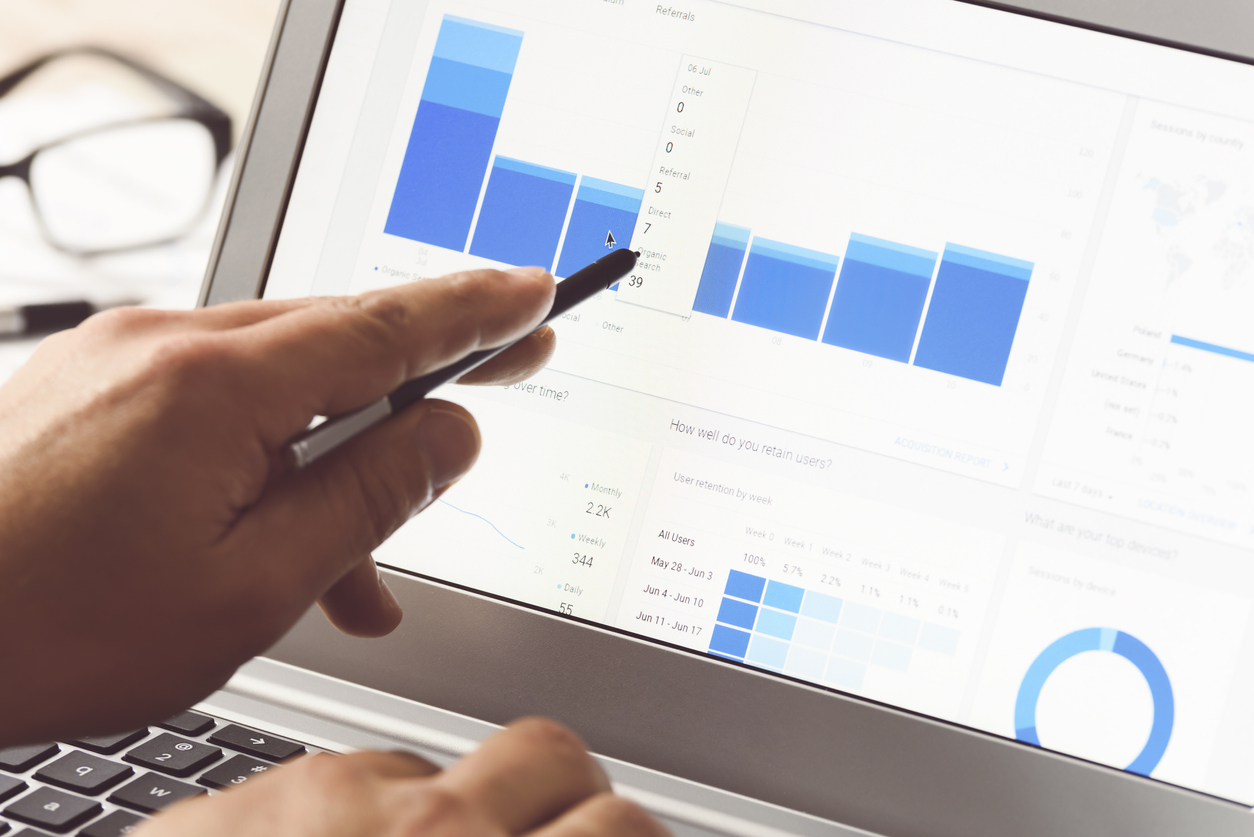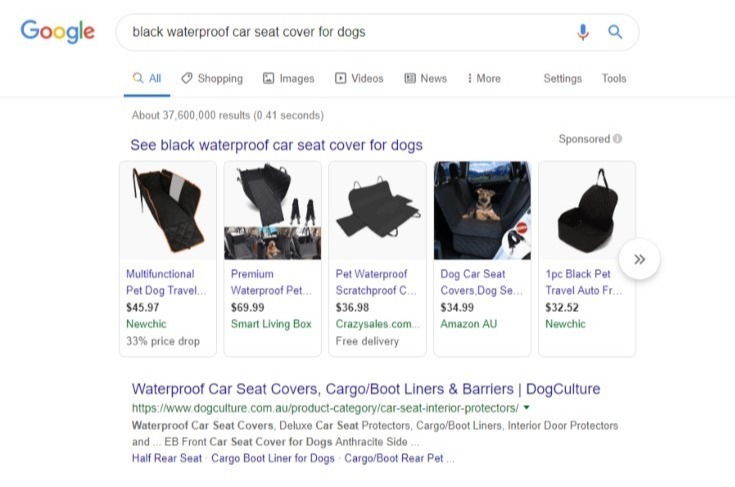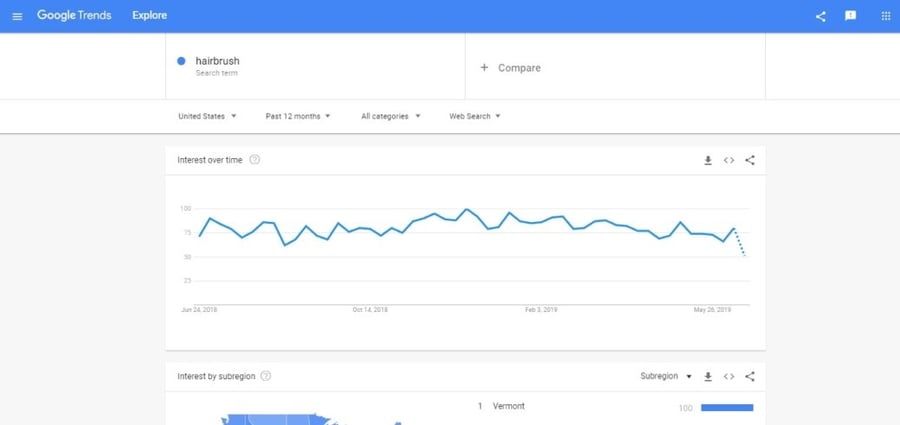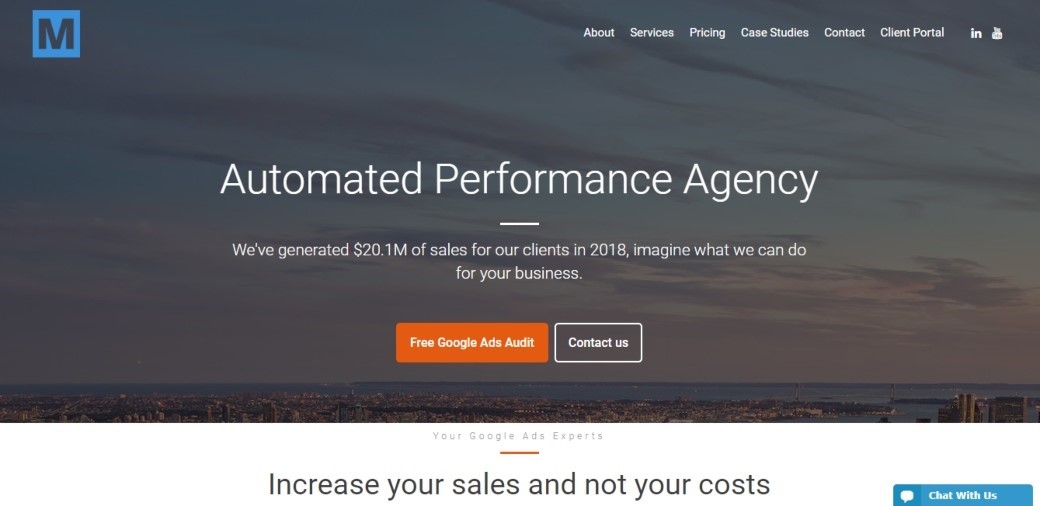
Have you just started an eCommerce store, but you’re struggling to get conversions? Maybe you’ve been in business for some time and were initially receiving lots of sales, but they've suddenly hit a plateau. There are plenty of ways to break through that barrier and continue succeeding with your business, and one of them is with the appropriate use of Google Shopping.
Google Shopping is a seamless way for shoppers to browse a range of products relevant to their search query. It isn't known as a "marketplace," but rather an advertisement platform that suggests applicable content, and is classified as a branch of Google AdWords. In this way, it's actually great for retailers. When a shopper clicks on one of these product links, they are directed to the retailer's site if they want to make a purchase.
This then opens up a whole new variety of possibilities: upsells if they see other products that interest them, brand information for trust, and perhaps you even have a blog they might subscribe to, thus gaining a potential long-term customer. Aside from this, if you're already using Google Shopping, you may not be correctly optimizing your advertisements to target the right customers.
If we've piqued your interest, keep on reading to discover the best tips to increase your conversions with Google Shopping.
Putting Your Product in The Spotlight
Unfortunately, your product won't be the first thing that appears on the front page of Google without some proper thought and planning.
Understanding Buyer's Intent
When someone opens their Google browser, they are ready to search for something they are interested in. Both the content and length of a particular search query informs you of a searcher's intent. Generally, the longer and more descriptive the search, the higher the buyer intent.
Someone who searches for "dog" might just be relaxing and showing their friends cute photos of dogs. Someone who searches for "black waterproof car seat cover for dogs" is likely someone who wants to make an immediate purchase when they find what they are looking for.
It's essential to understand your buyer's intent, so you can match what you’re selling to their wants and needs when they conduct a new search.

Tools Are Your Friend
You're not alone in the bid wars. There are fantastic tools that can help you rank and optimize your bids with SEO.
SEMrush
SEMrush will provide you with detailed insights about a domain or keyword. You can use it for keyword and competitor research. It's a handy tool for diving into each keyword and finding useful data much more efficiently than you would in Google Keyword Planner, for example. This tool has a free plan and paid plans depending on what you need.
Keywordtool.io
If you're trying to rank for a specific keyword and need some other alternatives, this tool gives you relevant keywords to go with the one you are trying to target. They are pulled from Google's Autocomplete suggestions and can be extremely useful in writing your description for your PLA. By using some of these relevant keywords, you will have a higher chance of showing up for a wider variety of searches.
Google Keywords Planner
This is a free tool and one that is used by most people. It is a tool in AdWords under the "tools" tab, and here, you can enter several keyword ideas, and Google will show you the data for them and other suggested keywords. The data includes estimated search volume, as well as average CPCs and what you can expect to pay for them if you so choose. This isn't exact data, but it gives you a general scope of things.
Manual Google Searches
Yes, even just the Google search is an excellent tool. You can start as you would when you search anything; put your desired keywords in and see what results show up in the Shopping section. Observe and be mindful of the products, prices, retailers, and images that show up to give you an exact idea of what you're up against. If you need keyword suggestions, this is a great way to find some.
Google Trends
Google Trends is an excellent tool for evaluating the trend of a search query. For example, "Hairbrush." You can see how the trend is quite steady and consistent, never falling below a ranking of 50. This is based on the United States and over the past 12 months.

Scrolling down, you'll also notice the top locations where the search term is used the most, and also other keyword suggestions that may have a good ranking trend currently.
You can change the filters to set the location, set a custom time range to analyze the trend over a specific period, set a category, and set the type of search. You can additionally compare two search terms to see which comes out on top. Overall, it's a very useful tool - and it's 100% free!
Optimize Your Listing
This is a step you need to be careful in and put a lot of thought into because it can ultimately mean the difference between a shopper clicking on your listing and scrolling right past it.
Product Title
Your product title needs to be as accurate as possible, so Google knows when to show your ad and to who. If you know the basics of SEO, then you know the product title should be similar to the title tag of a page on your website.
When setting the title, include your top keywords, use the obvious name of the product
(no messing around), use color/brand/size to differentiate and to phase out shopping candidates for your product, and place words strategically - for example, setting "Wedding Invitations" ahead of the amount, size, etc.
It's crucial to remember not to keyword stuff, be too vague, use all CAPS, or adding promotional text. These can penalize your PLA by Google; then what was all that effort for?
Product Description
Google analyzes your descriptions to help parse out which keywords will trigger your PLAs. If you get it wrong, your ads could be missing impressions from the right audience. Remember to concisely yet appropriately describe the item with all the details a buyer would need to make a purchase (without going overboard).
Just like the Product Title, we suggest placing sentences strategically within the first few sentences that have the most emphasis and selling points of the product.
Google Categories
Google has a vast list of categories that your products may fall under, and it's one more way for Google to understand what your product is. It's an important step to getting your products to appear for the relevant searches. As frustrating as it is to choose from Google's 6,215 categories, it is necessary. Choose the best category that suits your product and be thorough.
Image
Product images are perhaps one of the most critical elements of a great PLA. This needs to be high quality, have no watermarks or text, and it should focus only on the product you are selling to give your target customer an exact idea of what they're looking for. If customers can't see what you're selling clearly enough, then you're not going to get many clicks.
Price
This is a crucial determinant of whether or not someone will click on your PLA, especially if you are selling the same product as other retailers.
If you are selling a product for a high price and are targeting customers who are price sensitive, this can handicap your listing. More expensive items that are unique or have more advantages over competitors usually means it is better quality, and the expense is necessary. This does interest particular people, and you can target shoppers that are looking for quality and uniqueness if this is the case to help attract the appropriate clicks.
Custom Labels
These are for your benefit only, but can be useful when optimizing bids. When you look at performances in AdWords, and when you need to make bid changes, you can group products by custom label. These are beneficial in describing specific product attributes to make optimization less of a hassle later on.
Product Listing Ad (PLA) Scores
This is Google's way of encouraging their advertisers to create fantastic ads and landing pages. It leads to more ad clicks and happier users, and while it is similar to AdWord's quality score, it's not as clearly revealed what your exact quality score is.
In this case, your quality score is determined by your CTR or expected CTR, the relevance of your ad, and your landing page experience. Your ad rank is determined by the "Quality Score x Max CPC = Ad Rank" formula. The takeaway from this is clear - the higher the quality score, the less you pay over a competitor to still outrank them.
This is where the importance of a great product title, description, category, etc. comes into play, and it's even more of a reason to create a great PLA because your long term CPCs will be severely impacted by the overall quality and thought put into your feed.
Analyzing Data to Optimize Your Future Ads
Everything has a trial-and-error process, so it doesn't have to be all bad. Advertisements that fail to produce any conversions are still useful because they provide valuable data for you to analyze and learn from, thus allowing you to come back stronger with your future ads.
Google Analytics
Google Analytics is a highly recommended tool to integrate with your AdWords account due to the broad reports it gives of your website, products, and customer data.
Customer Engagement Data
This shows your engagement metrics, such as time spent on site, bounce rate, and average pages per session that will provide insight on overall performances.
Conversion Tracking
The many different ways you can dive into your conversion data in Analytics is quite useful. It will show you where ad clicks occur along the path to conversion to help you better understand what works and what doesn't.
Product Performance Report
This report in Google Analytics can show you which particular products are selling and which aren't.
RLSAs
Remarketing Lists for Search Ads (RLSAs) with Google Analytics integration provides you with an immense amount of ways to create new remarketing lists. These are created based on how shoppers interact with your site; you can create lists on pages someone visits, such as a product page, or you can even create lists on the amount of time they spent on your site. This results in smarter targeting options later down the track.
You can literally tell Google that you want to bid more when it sees a particular searcher you wish to target. This is especially useful if they have been to your site previously and made a purchase, for example, and now they have returned on Google search looking for a product they never realized you had in your range. In this case, you can tell Google to bid more for them.
You will need to add a "remarketing tag" to your site to enable remarketing or use Google Analytics to do so. You can see this help article by Google for further assistance on the subject.
Insights
Most eCommerce platforms come with insights that also let you analyze data based on how many people visited your website, which products were viewed the most, what they searched for on your website, your online conversion rate, and more.
By observing this data consistently and taking note of certain trends, you will be able to work out which products entice more interest and which are not succeeding at all.
Optimizing Bids
Your product is not going to appear anywhere if you don't correctly optimize your bids to meet your audience's criteria. Let's take a closer look at them.
Devices
What device are your ideal customers using? Is your product relatively inexpensive and something they could easily purchase on a mobile device? Or is the product something that they would be more likely to buy browsing on a tablet or investigating on a computer at home? Make this decision carefully.
Time of Day
People are often working during the middle of the day and are probably not thinking about purchasing an item online (unless you're sneaky in the office). Consider when someone would purchase your product - is it an expensive product that they need to do more research on, something that they would generally conduct at home after work? Then perhaps from 5-8pm would be a more ideal time to show your ads.
If it is office supplies, items that need to be regularly bought for office workplaces (paper, ink, etc.), then you want to target during work hours. Determine the best time someone is likely to purchase your product.
Day of the Week
This is something that can actually have a major impact on your sales, especially during holiday seasons. Mondays are usually days where people go back to work tired, depressed, and probably just spent a whole lot of money on the weekend. Not someone that is likely going to be shopping online, but again, this also depends on your product and the type of customer you are targeting (in reference to the previous point).
Towards the end of the week is perhaps a more likely time to target customers shopping for:
- Clothes to wear on a Friday night out
- Food, decorations, etc. for an upcoming party on the weekend
- Camping supplies for a weekend away camping
Seasonal items are great to start advertising just before the holidays start. This could be items like:
- Halloween/Christmas/Easter decorations and supplies
- Sun-safety items or travelling accessories for the Summer holidays
- Outfits, tools, and supplies for major upcoming events (festivals, car shows, etc.)
These are just some examples, but it entirely depends on your product, ideal customer, what they would use it for, and when they would use it.
Products with High Clicks but No Conversions
This is when shoppers are interested enough to click on your advertisement, but they don't make a purchase. This is usually a product page issue and could be due to many different reasons.
Do you offer free shipping? Do you offer guarantees if they don't like the product or it doesn't work? Do you have any product reviews to increase buyer intent? These are things that your competitors likely have that makes them have an advantage over you.
Process of Elimination & Recognition
When you first launch a campaign, you're going to have to increase your initial bids a few times to gain impressions and clicks more efficiently.
If you are confident in the quality of your feed, but you aren't receiving any impressions or clicks, then we suggest bidding more. Bump them slightly, from $0.01-$0.10 at a time until you start getting the results you want.
Lower bids are generally suitable for longer tail keywords with less competition. Despite this, longer search queries actually yield better conversion results because the targeting is more precise.
Higher bids are significant for branding, awareness, and competitive terms; these are for keywords that have really competitive costs.
Remember to increase bids on winning and best-selling products! If you have a product that is selling really well, then bump up the bid slightly. Invest your precious funds into promoting products that do perform well, and eliminate non-converting or poor performing products; especially ones that have been advertised for a long, unnecessary amount of time.
Unsure?
If all of this gives you a headache, confuses you, or if you simply don't have the time to try and optimize your products correctly or analyze critical data, another solution is to have professionals do it all for you, such as through an automated performance agency like Muzaara.
Muzaara is a Google Premier Partner and Google Retail Partner who offers a fully managed solution to work with clients and take the guesswork out of best practices, with a focus on increasing your sales and reducing your costs.

Automated performance agencies can help with various struggles, such as:
- Setting up or restructuring campaigns
- Account management
- Google Shopping Campaigns
- Account optimization and monitoring daily
- Custom comprehensive reporting (varied timeframes)
- Competitive analysis'
- Learning and adjusting as required
And more, depending on the services you pay for.
Each auto-performance agency comes with flexible pricing systems to suit your budget and preferences. All you need to do is tell them your budget, and they do the rest for you!
Ready to Start Converting?
If you've made it to the end of this post, give yourself a pat on the back and know that you are one step closer to converting potential customers into buyers.
These tips go hand in hand with one another - you need to ensure you are following the best optimization, analyzing, and buyer-intent practices to reach the best possible outcome.
Google Shopping is one of the most significant growth opportunities for most online retailers, and it's crucial to take advantage of that. As of 2018, Google Shopping ads drive 76.4% of retail search ad spend, generating 85.3% of all clicks on AdWords and Google Shopping Campaign ads!
The process of trying, making mistakes, learning, and trying again is tortuous; we know. Implementing these Google Shopping tips will ultimately lead you to more conversions, fewer headaches, and a better understanding of how the cookie crumbles in the world of Google Shopping.





Leave a reply or comment below